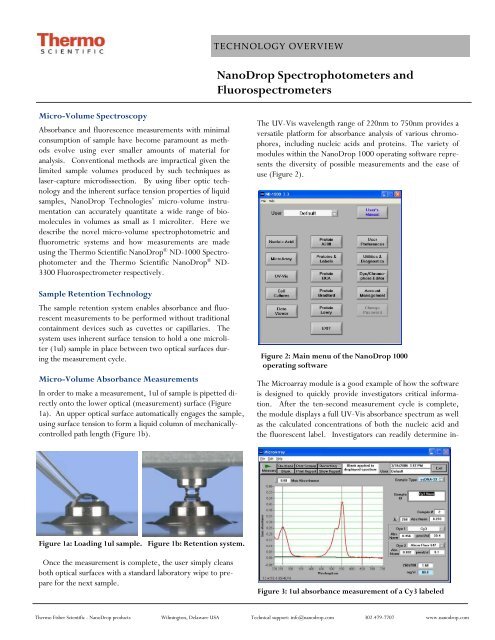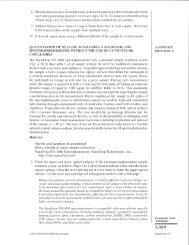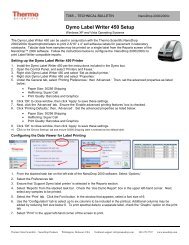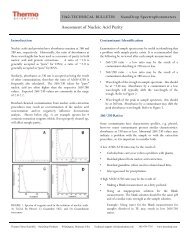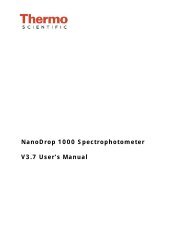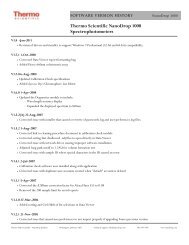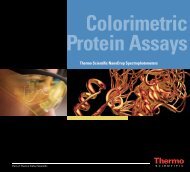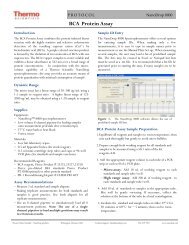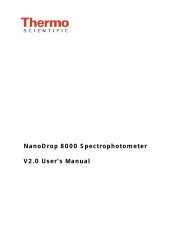NanoDrop Spectrophotometers and Fluorospectrometers
NanoDrop Spectrophotometers and Fluorospectrometers
NanoDrop Spectrophotometers and Fluorospectrometers
- No tags were found...
You also want an ePaper? Increase the reach of your titles
YUMPU automatically turns print PDFs into web optimized ePapers that Google loves.
TECHNOLOGY OVERVIEW<strong>NanoDrop</strong> <strong>Spectrophotometers</strong> <strong>and</strong><strong>Fluorospectrometers</strong>Micro-Volume SpectroscopyAbsorbance <strong>and</strong> fluorescence measurements with minimalconsumption of sample have become paramount as methodsevolve using ever smaller amounts of material foranalysis. Conventional methods are impractical given thelimited sample volumes produced by such techniques aslaser-capture microdissection. By using fiber optic technology<strong>and</strong> the inherent surface tension properties of liquidsamples, <strong>NanoDrop</strong> Technologies’ micro-volume instrumentationcan accurately quantitate a wide range of biomoleculesin volumes as small as 1 microliter. Here wedescribe the novel micro-volume spectrophotometric <strong>and</strong>fluorometric systems <strong>and</strong> how measurements are madeusing the Thermo Scientific <strong>NanoDrop</strong> ® ND-1000 Spectrophotometer<strong>and</strong> the Thermo Scientific <strong>NanoDrop</strong> ® ND-3300 Fluorospectrometer respectively.Sample Retention TechnologyThe sample retention system enables absorbance <strong>and</strong> fluorescentmeasurements to be performed without traditionalcontainment devices such as cuvettes or capillaries. Thesystem uses inherent surface tension to hold a one microliter(1ul) sample in place between two optical surfaces duringthe measurement cycle.Micro-Volume Absorbance MeasurementsIn order to make a measurement, 1ul of sample is pipetted directlyonto the lower optical (measurement) surface (Figure1a). An upper optical surface automatically engages the sample,using surface tension to form a liquid column of mechanicallycontrolledpath length (Figure 1b).The UV-Vis wavelength range of 220nm to 750nm provides aversatile platform for absorbance analysis of various chromophores,including nucleic acids <strong>and</strong> proteins. The variety ofmodules within the <strong>NanoDrop</strong> 1000 operating software representsthe diversity of possible measurements <strong>and</strong> the ease ofuse (Figure 2).Figure 2: Main menu of the <strong>NanoDrop</strong> 1000operating softwareThe Microarray module is a good example of how the softwareis designed to quickly provide investigators critical information.After the ten-second measurement cycle is complete,the module displays a full UV-Vis absorbance spectrum as wellas the calculated concentrations of both the nucleic acid <strong>and</strong>the fluorescent label. Investigators can readily determine in-Figure 1a: Loading 1ul sample. Figure 1b: Retention system.Once the measurement is complete, the user simply cleansboth optical surfaces with a st<strong>and</strong>ard laboratory wipe to preparefor the next sample.Figure 3: 1ul absorbance measurement of a Cy3 labeledThermo Fisher Scientific - <strong>NanoDrop</strong> products Wilmington, Delaware USA Technical support: info@nanodrop.com 302-479-7707 www.nanodrop.com
2By design, the <strong>NanoDrop</strong>-1000 eliminates fixed containmentdevices such as cuvettes <strong>and</strong> capillaries, enabling an automaticpath length change from 1mm to 0.2mm during the same measurementcycle of a given sample. This allows for an unprecedentedrange of sample concentration to be assessed throughabsorbance spectroscopy (2 ng/ul to 3700 ng/ul for dsDNA),essentially eliminating the need to perform dilutions.Micro-Volume Fluorescence MeasurementsUsing the same sample retention technology, the <strong>NanoDrop</strong>3300 performs full spectrum fluorescent analysis of one microlitersamples without the use of cuvettes or capillaries. Thelever arm of the <strong>NanoDrop</strong> 3300 is opened <strong>and</strong> 1-2ul of sampleis pipetted onto the optical surface. The lever arm then engagesthe upper surface of the sample to capture <strong>and</strong> hold thesample in place during the measurement cycle. Once complete,the sample is wiped away using an ordinary laboratorywipe. Fluorophore excitation occurs from one of three solidstatelight emitting diodes (LEDs): UV, Blue, or White. Thebroad excitation range allows for a wide range of commonfluorophores to be measured without the need for filter changes(Figures 4).UVBlueWhiteGFP wtQuinine SulfateHoechst 332584-MuQ DotsEGFPFITC-FAMAlexa 488PicoGreenRiboGreenAlexa 555B-PhycoerythrinQ DotsCy3, Alexa 555Alexa 568Cy5, Alexa 647Sulforhodamine 1015-CMTRQ DotsTETHEXFigure 4: LED excitation spectra <strong>and</strong> comon fluorophoresThe uniquely clean optics of the retention system <strong>and</strong> proprietarysignal processing enable the unconventional use of thebroad-spectrum, white LED. The broad excitation of the whiteLED can be used to excite several fluorophores, allowing for amultiple emission profile from a single sample (Figure 5).Figure 5: Multiple fluorophore emission output.Ultra-Low Sample Mass Detection LimitThe small sample volume requirement of the <strong>NanoDrop</strong> 3300allows significantly scaled-down fluorescent reaction volumes (2-10ul) <strong>and</strong> therefore utilizes only a fraction of the sample consumedby cuvette- or plate-based fluorescent measurements.Even though the <strong>NanoDrop</strong> 3300 does not measure ultra lowconcentrations, it does lower the fluorescent detection limit ofsample mass by more than an order of magnitude. For example,using the PicoGreen ® dye, the <strong>NanoDrop</strong> 3300 can detect aslittle as 2 pg dsDNA, while a cuvette or microplate PicoGreen ®assay would need at least 25-50 pg dsDNA for detection (TableA)Table A: PicoGreen ® assay detection limitsDetection limitby sample massDetection limitby concentrationNano-Drop33002 pg (in 2ul)MicroplatereaderCuvette-basedFluorometer50 pg (in 200 ul) 25 pg in 1 ml1 pg/ul 0.25 pg/ul 0.025 pg/ulFor those working with limited sample quantities, the<strong>NanoDrop</strong> 300 enables measurements that are simply notpossible using cuvette or plate-based fluorescent spectroscopy.In SummaryOur novel retention system not only enables quality absorbance<strong>and</strong> fluorescence measurements with only a minute fractionof sample material needed to perform similar analyses onmore traditional systems, but its ease of use provides a practicalalternative for all spectroscopy measurements.Rev 5/08Thermo Fisher Scientific - <strong>NanoDrop</strong> products Wilmington, Delaware USA Technical support: info@nanodrop.com 302-479-7707 www.nanodrop.com


